




I am a Native American Hunter
On September 22, I took the Washington State Hunter Education Traditional Classroom Course and passed the written exam and field course! This has been a goal of mine for the past three years. I wanted to get my hunter education card last season, but didn’t feel I was prepared for the exam and field course, yet. I studied all year and finally worked up the nerve to sign myself up!
I do not do well with online classes, so I knew right away that the in-person class would be more suitable for me. I was one of three female students; one of them was a young girl who was more knowledgeable than me! I could tell she’s been on hunting trips her whole life and was raised to learn that way of life. The two-day courses were all day and filled with lots of information and educational videos, and it was very interactive. If you tried to stay quiet, they would call on you to read and answer questions, so there was no room for shyness and modesty.
This experience made me feel like a student again. I am very proud of myself for sticking with it and fulfilling my goal of becoming a Native American hunter.
My brother-in-law, Jesse Ammons, let me borrow his son Wyatt’s .306 rifle for my first hunting trip in Mazama. As much as I wanted to train my body for this trip, I did not and my body sure paid the price. I feel like I lost 5 pounds during my three days of hunting.
Even though I didn’t get a deer, I learned so much! I even checked off a few life goals while on this trip - I’ve always wanted to hunt with my husband, Kyle Ammons, and as odd as it sounds, eat lunch with him quietly on the side of a steep mountain.
October reminds me of my dad because it is his birthday month. When he was still alive, I remember asking him where his friends took him and more so what did he see in the forest when they saw a buck. He said, “hunt where the mushrooms grow.”
Caroline Ammons goliahlitza
I came home less anxious and felt revitalized from the quietness in the forest. It made me want to write. I wrote this poem:
The Rise of the Hunter Moon I could barely slip away from work to seek out the illumination of the moon.
The gray blue clouds moved swiftly; the chill in the night’s air felt so right.
The reflection of the six cow’s eyes scared the excitement right out of me.
At dawn, I scrambled, not knowing what I was doing all the way out there.
As the sun rose, the sound of the forest was like music to my ears, classical notes silently creeping about.
My bodies stress could be no more, for there was only déjà vu and a tiny bit of solace.
As I approached a grouse, it tilted its tiny head at me.
The sound of the forest warmed my heart.
My dad’s birthday is days away.
When the leaves are falling bright.
It was during the rise of the hunter moon; I dreamed vividly but with no deer in sight.
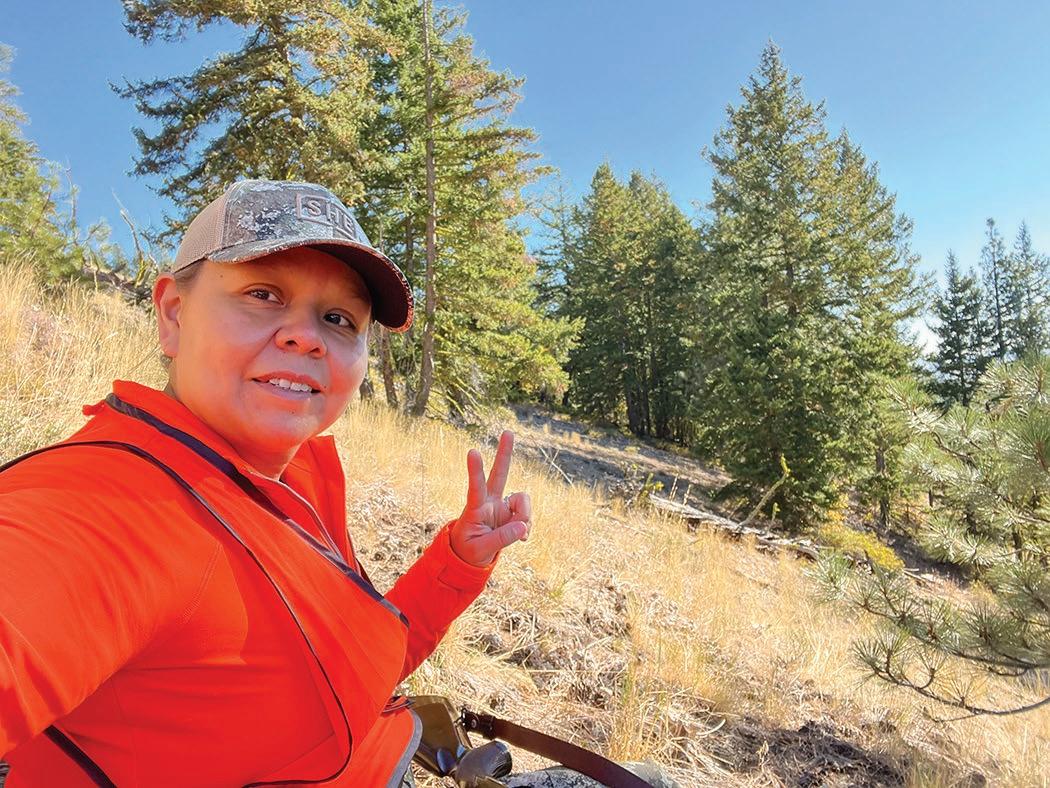
yal le ka but
Steve Edwards, Chairman (360) 840-5768 | sedwards@swinomish.nsn.us
siwelce?
Alana Quintasket, Vice Chair (360) 302-0971 | aquintasket@swinomish.nsn.us
ya qua leous e
Brian Porter | Secretary (360) 840-4186 | bporter@swinomish.nsn.us
taleq tale II
Barbara James | Treasurer (360) 391-3958 | bjames@swinomish.nsn.us
qws stania
Aurelia Bailey (360) 853-6376 | awashington@swinomish.nsn.us
sapelia
Sophie Bailey (360) 853-6458 | sbailey@swinomish.nsn.us
spi sta yup ton
Greg Edwards (360) 854-8612 | gedwards@swinomish.nsn.us
yellakabol
Bruce James Jr. (360) 708-5779 | brucejames@swinomish.nsn.us
sa bal sha good
Rodney John (360) 708-1387 | rjohn@swinomish.nsn.us
kuts bat soot
Jeremy Wilbur (360) 770-7447 | jjwilbur@swinomish.nsn.us
kani?ted
Tandy Wilbur (360) 770-3050 | tandywilbur@swinomish.nsn.us
The mission of qyuuqs News is to provide monthly communication to Swinomish Indian Tribal Community Members near and far. We are committed to serving as an apolitical forum for the Swinomish governing officials and all Community Members. qyuuqs News is not intended to reflect the official position of the governing body at Swinomish Indian Tribal Community but rather reflects the ideas, events, and thoughts of individual Community Members and Tribal staff. As such, the Swinomish Tribe makes no claim as to the accuracy or content of any of the articles contained therein.
17337 Reservation Road, La Conner, WA 98257
Phone (360) 466.7258
*SUBMISSIONS
Send your news tips, stories, and photos to: qyuuqs@swinomish.nsn.us
Submission deadline: 10th day of the month
QYUUQS NEWS
Caroline Ammons, Editor qyuuqs@swinomish.nsn.us
SWINOMISH COMMUNICATIONS
Heather Mills, Communications Manager
Sarah Kellogg, Content Journalist
Katie Bassford, Staff Photographer
Jordan Ekdahl, Graphic Designer communications@swinomish.nsn.us
ADVISORY COMMITTEE
Tracy James, John Stephens, Kevin Paul
This issue is available online at swinomish-nsn.gov/qyuuqs
Photos credits: qyuuqs News Staff or as credited. All rights reserved.
Facebook: Swinomish qyuuqs News
Linkedin: Swinomish Indian Tribal Community
*qyuuqs News is made available for viewing on the Internet
When submitting information, stories, and/or photos, please be aware everything published in the print version of qyuuqs News is also published on the Internet and is available to the world. Please consider carefully whether your submissions contain anything you feel may not be suitable or appropriate for the Internet. By submitting your information, stories, and/or photos to qyuuqs News, you agree to publishing your submission in both the print and online versions of qyuuqs News.
Website: swinomish-nsn.gov
@SwinomishSenate
qyuuqs News is a publication of the Swinomish Indian Tribal Community produced by Swinomish Communications.
PATIENTS CAN LOOK FORWARD TO HOME VISITS AS AN ACCESSIBLE HEALTHCARE OPTION
The Swinomish Medical Clinic is excited to share that David Johnson, PA-C, will be returning this December as a fulltime community health outreach provider. The clinic is also excited to share that David will be offering a whole new service in his new role – patients can look forward to the convenience of home medical appointments.
Services available at home appointments include:
♦ General wellness exam
♦ Treatment of chronic medical conditions
♦ Evaluation of acute illness and new medical issues*
♦ Basic and routine lab work
♦ Consult and treatment of substance use disorder
All active Swinomish Medical patients will be able to request home visits. Priority will be given to elders and patients with certain medical needs, including those who have difficulty accessing the clinic for any reason and patients with a chronic illness or substance use disorder.
We look forward to assisting you in reaching your healthcare goals by providing high quality, safe, and confidential medical care at home!
Call the clinic with questions or to schedule your next appointment – (360) 466-3167
*Patients are encouraged to call 911 for any emergent or life-threatening medical issues.

Our Tribe is seeking $20 million in funding through the EPA Environmental and Climate Justice Community Change Grants program. If awarded, one major project that would be funded includes weatherization and energy e iciency upgrades for ALL tribal member households on the reservation, regardless of income. Help us fine tune the application by completing the survey by December 17. Please visit:
Ra le winners announced December 18 for those who enter!
BRIANA PORTER, OFFICE OF TRIBAL ATTORNEY
The Swinomish Senate, the governing body of the Swinomish Indian Tribal Community, recently enacted the following code amendments:
At the September, 2024 Senate meeting, the Senate made revisions to the Tribal Tidelands Code. The revisions preserve, restore, enhance, and protect the ecological, cultural, spiritual, aesthetic, economic and other values of tribal tidelands and prevents serious and substantial threats to the political integrity, economic security and health and welfare of the Tribe. The Kukutali Committee and Legal Committee recommended the amendment, which the Senate enacted on September 17, 2024.
Notice: To all persons claiming an interest in the property listed below
The Plaintiff Vernitta Lewis is initiating a Quiet Title action on the building located at 17488 Pioneer Parkway, La Conner WA 98257
Quiet Title actions are used to determine the ownership interests in homes and other buildings. The Quiet Title will be filed in the Swinomish Tribal Court.
Any person wishing to assert a right, title, or interest in any of the buildings at the address listed, should contact the Swinomish Tribal Court to obtain the necessary paperwork to file your claim.
Swinomish Tribal Court [Social Services Building] 17337 Reservation Road La Conner, WA 98257
Contact for Quiet Title Hearing Schedule
Blair Page, Swinomish Tribal Court Clerk
Phone: (360) 466-7217
Email: bpage@swinomish.nsn.us
At the October, 2024 Senate meeting, the Senate made revisions to the Tribe’s Elections Code. The amendment will clarify the Tie Break procedures for Swinomish Senate Elections. The Election Board recommended the amendment, which the Senate enacted on October 1, 2024.
The amended code and Constitution are available for review on our website at swinomish-nsn.gov. Paper copies are available for review at the Tribal Court Clerk office or the Office of the Tribal Attorney.




TUES. NOV 19
Will & Estate Planning Class 11 a.m., Senior Center
DEP Environmental Learning Series: Learn to Harvest & Process Rosehips 12:30-2:30 p.m., Lodge at Thousand Trails
Community Update Meeting: Opioid Crisis Response Update 6 p.m., 6 p.m., Senate Chambers or Zoom
WED. NOV 20
Mind Your Mental Health Fair
3:30-5 p.m., Boys & Girls Club
MON. NOV 11
Veterans Day
THURS. NOV 28 Thanksgiving Day


Donna Jean was born on November 27, 1976 in Olympia, WA. to Terry Evans and Lydia Charles Ikebe. She gained her angel wings on October 4, 2024 at the Providence Hospital in Everett, WA, after a long few months of suffering from ALS. Donna fought hard to overcome this rare disease as the doctors searched for answers. In the end, her body was just too tired. Sissy grew up and lived her whole life on the Swinomish Reservation, she attended La Conner Schools and loved her friends and family dearly. In her younger years Sissy worked for the Swinomish Daycare, she spoke of the amazing ladies she worked with, they taught her how to be a mother and mentored her to be the great caretaker she was. Later, her passion was being a fisherwoman, it was hard work and long enduring hours on the water. She loved her time with her brothers and it gave her the ability to provide the best she could for her children. No matter how good or bad the money was, it was her place of happiness. In 2005, Donna joined the Swinomish Smokehouse, she was dedicated to her spiritual life. She helped many girls come into the Longhouse to change their lives and they all became her daughters. Sissy was a private person and she kept her circles small, if you were lucky enough to be her friend you had a friend for life. She was a generous person and made sure to share her harvests with Elders who needed it. She absolutely cherished her time she spent with all her children; she loved having the little ones around and she became Auntie Bunny to several babies in our community. Her family meant the world to her, she would do anything to for her mom, her brothers, her children and her nieces/nephews. Her beautiful smile, the amazing pictures she shared from the water, the drives she took while listening to music and her loving personality will be deeply missed. A mom became an Angel, her wings will flutter over her babies and her spirit will always guide and protect them. Rest in the beautiful place that you shared through your lens Sissy.
Donna is proceeded in death by her grandparents; Norval Charles, Gertrude Bobb, Leo Evans & Annie Bobb. Her brother Leonard who she missed dearly. Aunt Alice Charles, Uncles Jimmy Charles & Leo Evans Jr.
She is survived by her children Alyssa McCormick, Boyce Charles, Katerina, Carlee Jo, Ronnie Elizabeth Edwards, Cary and Caylen Bobb. Parents Lydia Charles and Terry Evans, Brothers Tabe Ikebe, Tandy (Diane), Zach (Jessica) and Zeb Grossglass, Tara, Jared, Cecilia Evans, Felicia Sines & Marcie Lozeau. Numerous Aunts, Uncles, Cousins and Nieces/Nephews.
The family would like to thank her nurse Lynn and all the staff at Providence for all of support they gave the family. They are forever grateful to the ones who came and sat with them at the hospital and the entire community for the love, support & prayers sent to Donna and the entire family. She’s fishing on that eternal water with all the greats who went on before her. Hysheqa’Siam

Roger passed away on October 21, 2024 at the Skagit Valley Hospital. Roger was born to Roger Clark Sr. and Lois Jean Bailey on December 16, 1955 in Tacoma, WA. Roger was baptized in the Catholic church, learning his strong beliefs from his mother Lois Jean and grandmother Myrtle. Roger attended La Conner Schools, where he graduated. Roger had 9 children, Ivie, Salina Guss, Donal, Cora, James, Jean, George, Roger III, Cora Clark. He loved and cherished all of his children; they didn’t always get along but the love was always there. His children gave him 11 grandchildren Crystal, Molly Clark, Natalie, Kaylena, Misanes, Nanette & Temayah Clark, Kenai Clark, Anthony, Lloyd, Kandace, Martie McClean and he had 8 grand-children Tristan Roberts, Katherine Misanes, Michael Roberts Jr., Aiden Roberts, James, Nicole Madison, Dason, Jayden McClean, baby on the way in 2025. Roger was first and foremost a commercial fisherman. Over the years he was a fish cook in La Conner. Roger was a very good bread maker. He was a grave digger for the Swinomish Community for many years. Roger joined the Bailey Smokehouse in 1973, Roger firmly believed in the smokehouse teachings and culture. Roger would regularly attend many different stick game tournaments around Indian Country, mostly traveling with Bully & Carrie his closest and cherished brother and sister. Roger had met many people in his travels whether it was in the smokehouse or at stick games. He was a very loud and vocal and you always knew when he was in the house. When he would attend a gathering, he had a speech that he always gave and always started with, “My mom always said to get up and thank the people.”
Roger is proceeded in death by his Parents, Roger Clark Sr. & Lois Jean Bailey, Siblings: Cheryl, Mike Clark, Pete Jr., John, Liz, Ray Fornsby Sr., Nephew Ray Fornsby Jr., Daughter; Cora Clark, Grandparents; William Bailey and Myrtle Dan, Alden Clark an Elma Palmer, numerous Aunts & Uncles.
Roger is survived by Phyllis McCoy, Viola Clark, Ivie, Selena Guss, Donald, James, Jean, George, Roger III, Cora Clark, Crystal, Molly Clark, Natalie, Kaylena Misanes, Nanette and Temayah Clark, Kenai Clark, Anthony, Lloyd, Kandace, Martie McClean, Tristan Roberts, Katherine Misanes, Michael Roberts Jr., Aiden Roberts, Phil Milford III, Edward, Warren, Ricky, Randy Fornsby, Wayne and Carene Fornsby, Jenieva Tom, Dave and Janet Williams, number Cousins, Nephews and Nieces, Friends and stick gamers.

Winterizing your home is important to keep your home safe and save you money in the process. These steps will keep your home running efficiently, and your property protected from the elements.

Burst pipes are one of the most common and expensive winter headaches for homeowners. The good news is you can prevent frozen pipes with little effort. A small amount of work to prepare for cold weather will save you money and avoid a mess.
First, always maintain a temperature of at least 60 degrees Fahrenheit in your home. This will help keep the water in your pipes from freezing and expanding when temperatures drop too low.
Most home insurance companies won’t cover burst pipes in the home if the temperature is set too low. Setting your thermostat at 60 or above helps guarantee even the coldest parts of your home won’t drop below freezing.
Pipes on the exterior of your home that provide water to garden hoses or a sprinkler system can freeze much faster when temps dip.
You can do the following to prevent burst pipes:
‣ Disconnect and store hoses
‣ Open the outside valve to allow any remaining water to flow out
‣ Turn off the shutoff valve inside your home that supplies water to the outside pipes
Many homes have an indoor drain valve near the shutoff valve. Use this to drain any remaining water out of the line. Consider installing a valve to release pressure if your home doesn’t have one.
While some homes have heated basements, others are built on top of crawl spaces. If you’re a homeowner with a crawl space, you’ll have to take extra steps to prevent the pipes from freezing during the winter season.
Here’s what you can do:
‣ On the coldest days, close the crawl space vents. Make sure to open them when it warms back up, as these vents keep your crawl space dry and prevent mold and mildew.
‣ Insulate the crawl space and pipes, and seal any cracks or holes that allow cold air in.
Your heating system needs to run properly for your house to stay comfortable in the winter. Whether you have a furnace, boiler, or some other form of heater, regular maintenance will help your system run efficiently and last longer.
Buy the appropriate filter for your home if you have a furnace or heat pump. Filters can range in quality, price, and the length of time they last, usually from three months to a year. In the event you have pets or a particularly dusty home, you may be better off changing the filter more frequently.
If your home lacks proper seals, cold air can infiltrate your living spaces, create cold drafts, and force your heating equipment to run longer. Fortunately, caulk and weather stripping are easy and affordable ways to improve the seals on your doors and windows.
A main pathway for air to come into your house is between the door and the frame. You can reduce the air leakage through your exterior doors by sealing the gap between the door and frame by adding or replacing weather stripping. You can also install a door sweep at the bottom of your door to block cold air.
Another place to insulate is around your windows. Improving air tightness by winterizing your windows will lower your heating bills and reduce drafts in your home.
To do so, follow these steps:
‣ Determine which windows are leaking. On a cold day, run the back of your hand along the interior frame of the window. If you feel cold air, the window is drafty and a candidate for improvement.
‣ Seal the leaks with caulk. Use an exterior-rated caulk to seal around the exterior perimeter of the window. You can also use caulk to seal the cracks between the interior window trim and the wall.
If you use a wood-burning fireplace or stove during the winter, have it inspected and cleaned by a professional chimney sweeping service. This may reduce the risk of a house fire, extend the life of your fireplace and chimney, and help prevent smoke damage in your home.
Likewise, if your home uses a flue to vent exhaust from your furnace, you’ll want to have an expert examine it. You’ll need to clear blockages, replace eroded or loose parts and check for missing flue caps. A heating system professional can help ensure everything is working properly.
Clean gutters are important as they direct melting snow and water away from your home. If your gutters are clogged with leaves and other debris, they won’t be able to perform their intended function.
Blocked gutters can cause ice build-up that can damage your gutters or your property if they fall. It’s essential to clean your gutters before the winter hits.
If you’d rather not get on a ladder to do the job yourself, you can hire a professional gutter cleaning company.
The last step is to protect outdoor fixtures. This means bringing in anything that won’t survive the cold, covering furniture and fixtures and securing other equipment for winter. Here’s a list of things you may need to do:
Cover your grill and, if it’s propane-fueled, disconnect it from the propane tanks, storing them for the winter.
‣ Bring in patio furniture cushions.
‣ Cover patio furniture.
‣ Cover and winterize your pool.
‣ Prep your fire pit by removing ashes, if wood-fueled, or disconnecting it from gas.
‣ Clean your deck, removing dirt, mildew, leaves and other debris.
Winterizing your house will save you money on your heating bills, but that’s just the start of it. By winterizing your home, you’re prolonging its life and preserving its function and value. Take the steps to winterize your home and enjoy the coziness of winter.

Source: rockethomes.com/blog/homeowner-tips/winterizing-a-house
Nearly a year ago, your Fisheries Department published the “Swinomish Climate Change Adaptation Strategies for Shellfish.” Please see the May 2024 qyuuqs News issue for a reminder of its broad scope and ambitious goals. As promised, here is the first of four articles diving into each strategy and explaining where Swinomish members fit in.
Preserve ecosystems that are still intact
In the same way that we are better able to deal with life’s trials and tribulations when we are well fed, exercised, and rested, healthy ecosystems are more capable of adjusting to stressors than degraded environments are.
Intact, healthy coastal ecosystems provide many benefits to human and non-human communities like cycling nutrients, trapping sediment, filtering water and retaining carbon. These areas also provide a variety of habitat types that support shellfish. Preserving these areas is easier, more successful, and more cost-effective than trying to restore areas that have been damaged by pollution, development, and other human activity.

Goal 1: Protect Intact critical transition zones
‣ Protect connected coastline and habitat diversity
‣ Protect important juvenile Dungeness crab habitats
‣ Ensure use of climate change projections in protection plans
‣ Collect species abundance and habitat use data to prioritize protection areas
LINDY HUNTER, FISHERIES TECHNICIAN
In short, our first strategy is: protect what we still have. There are some simple things and some rather in-depth things we can all do to assist in this strategy.
An easy place to start is on the water. When out fishing, avoid running your boat through floating algae and kelp beds. This not only protects your motor but also keeps those prime nursery habitats, and all the critters that find sanctuary there, intact.
Additionally, you can advocate for the use of natural or soft armoring on shorelines instead of hard bulkheads to support healthy beaches. And finally, plant trees. They help with everything.
Come talk to your Fisheries Department if you have questions or comments. We would love to hear your ideas on other ways to protect healthy spaces and marine life.

Goal 2: Protect seagrass beds and kelp forests
‣ Protect and restore kelp and eelgrass beds
‣ Monitor kelp and eelgrass beds & identify conservation areas
‣ Better understand effects of kelp beds on seawater chemistry
‣ Study how ecological change will impact kelp and eelgrass

Goal 3:
Protect climate and ocean acidification refugia
‣ Encourage seaweed farming near tribally-important beaches
‣ Identify beneficial refugia for target species
Project Name: Swinomish Fishing Infrastructure Improvements
Proponent : Swinomish Indian Tribal Community (SITC)
Lead Agency: U.S. Department of Transportation Maritime Administration (MARAD)
Proposed Project: The purpose of the Environmental Assessment (EA) is to evaluate the potential impacts of the proposed project on the environment and determine if there would be adverse impacts requiring the preparation of an Environmental Impact Statement. The proposed project is a group of three actions:
‣ Four-lane boat ramp and short-term parking
‣ Fixed pier replacement
‣ Moorage float replacement
The purpose of the proposed project is to improve fishing infrastructure within the Swinomish Channel to support the tribal fishing fleet. Tribal fishers must currently drive a minimum of eight miles to the nearest commercial boat launch. In addition, portions of the existing fishing infrastructure do not support the needs of the Swinomish fishing fleet and require replacement.
Location: Western shoreline of the Swinomish Channel on the Swinomish Reservation
Document to be Prepared: MARAD (lead agency) and the SITC (proponent) have agreed that an EA will be prepared under the direction of MARAD.
The lead agency has identified the following areas that require discussion in the EA:
‣ Land Use
‣ Soil, Geology, and Seismicity
‣ Water Quality
‣ Waters of the U.S.
‣ Wetlands
‣ Air Quality
‣ Noise and Vibration
‣ Floodplains and Climate Change
‣ Hazardous Materials and Waste Management
‣ Public Services and Utilities
‣ Traffic and Safety
‣ Visual Resources
‣ Threatened and Endangered Species, Critical Habitat, and Essential Fish Habitat
‣ Migratory Birds
‣ Marine Mammal Protection Act
‣ Cultural and Tribal Resources
‣ Socioeconomics and Environmental Justice
Scoping: Community members, neighbors, the public, organizations, and agencies are invited to comment on the scope of the EA.
Request for Comments: Comments on the scope of the EA are due on or before January 17, 2025. Comments can be provided as follows:
‣ Email to Brett Lizotte at blizotte@swinomish.nsn.us
‣ In writing to Brett Lizotte, Harbormaster, Swinomish Indian Tribal Community, 11404 Moorage Way, La Conner, WA, 98257
‣ By calling (360) 708-3397

Imani Espinoza, Nani Luna, Aloni Edwards, Noami Guzman
MICHELLE SKIDMORE, NUTRITIONIST
More than 38 million Americans have diabetes. Diabetes most often develops in people 45 or older, but more and more children, teens, and young adults are developing it. Type 2 diabetes affects approximately 23,000 children and adolescents in the United States, Native youth having the highest rate.
Diabetes is a chronic disease that affects quality of life, health, and longevity.
“There’s often the assumption that young people don’t develop complications from diabetes, but that’s just not true. Young people with diabetes do develop signs of complications in the prime of their lives,” said Dr. Barbara Linder, an advisor for childhood diabetes research from National Institute of Health.
Youth with Type 2 diabetes have an increased rate of high blood pressure, high cholesterol, and nonalcoholic fatty liver disease.
Youth risks for developing diabetes:
‣ Larger body
‣ Family history diabetes
‣ Signs of insulin resistance (darkened/velvet skin, polycystic ovary syndrome)
‣ Elevated blood pressure or cholesterol
‣ Birth mother with diabetes during pregnancy
‣ Small or large birth weight








Diabetes screening can start at age 10 or at the start of puberty, if younger. Screening for diabetes is done with a blood test. Talk to your family doctor for more information about youth diabetes screening. With early detection and action, you can prevent diabetes.


































































































































































































































































JOSIANE SAMS, SWINOMISH TRIBAL MEMBER
This story is about the health journey of Swinomish youth Ava Day-Sams and her mom Josiane Sams. It started this spring when Ava’s doctor referred her for a metabolic health screening. The results came back high risk for developing Type 2 diabetes and heart disease.
Josiane was scared, “My dad died of a heart attack and had Type 2 diabetes.” Josiane herself was at risk for diabetes, but she didn’t let it worry her. However, with Ava at risk, everything changed. “Nobody wants their kid to get anything life threatening. That was the beginning of the journey.”
Josiane knew the family would have to change how they ate. The family had gotten in the habit of eating and drinking whatever tasted good - nothing was off limits. These foods offered lots of taste satisfaction but increased Ava’s health risks over time.
Josiane made an appointment with the nutritionist, talked with family, and searched the internet for better ways to eat. “To go food shopping was frustrating in the beginning. I wasn’t used to the eating healthy lifestyle, but now it is easy. People need to be aware of what is in their food. They just don’t know.”
Healthier eating was new for Ava, too. She often did not want to try the new foods Josiane was cooking. “I had to explain to her what happened to her granddad and that we have to be healthy now.”
Ava understood in time and started eating the new foods. She will try everything once, liking most of Josiane’s cooking. She still gets treats on occasion, in smaller servings or with less sugar. Ava has learned what she can eat often and what is for special times only.
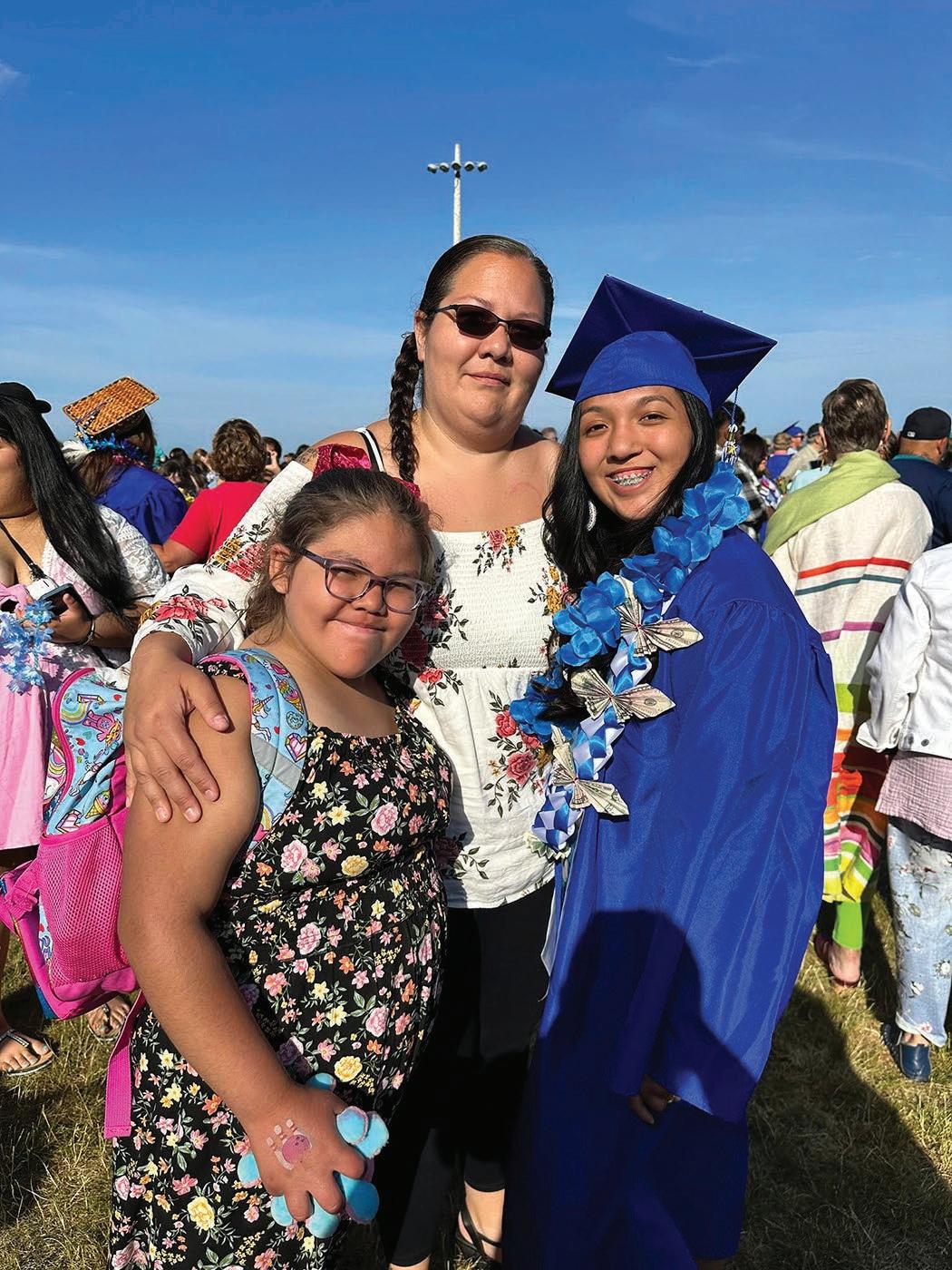
With less sugary and fatty foods, and smaller servings, Ava’s body changed. She is now playing with kids rather than sitting. She is getting more restful sleep. She is no longer complaining of body aches. Ava is now calm and steady with her moods.
Josiane says, “She is having life experiences rather than just watching. I am happy to see her running with friends.” Ava has also had a modest decrease in risk of chronic diseases.
Josiane is Ava’s support person for health. Youth cannot make changes on their own. They need family to share the experience of new choices, and to know changes are safe and okay.
Having a parent role model is a strong predictor of health success. “People just need to try it. It is not that hard for us now.”
‣ Choose food and drinks with less or no added sugars
‣ Buy low-fat and fat-free foods when available
‣ Eat chicken, turkey, and fish over beef
‣ Eat fresh or cooked vegetables every meal
‣ Switch to whole grains when you can
‣ Eat mostly at home, less eating out
‣ Meal prep on the weekend for fast weekday meals
‣ Pack lunches to eat away from home
‣ Experiment with recipe substitutions and new ingredients
‣ Shop early morning or evening when stores aren’t crowded

November, 2024







4 MON Goodwill Outlets Everett Bin Shopping Leave at 8:30 a.m.
11 MON
Veterans Day Tribe is Closed
5 TUES "Fill Your Plate"
Come Join us in the fun activities with Michelle Skidmore. Fun Giveaway and food at 3p.m
12 TUES Free Haircuts for Elders at Hair Republic Sign up at the Senior Center
6 WED Tulalip BINGO Lunch provided at Bingo for Elders Leave at 10:30a.m.

1 FRI Craft Day Come work on crafts at 10a.m.
18 MON Art Class at the Library 1-4p.m.
19 TUES Estate Planning Class at Senior Center. This is for Will Planning, Power of Attorney, etc. 11a.m.
13 WED Barrier Breakers Free Phone 10-11a.m.
7 THURS
Slahal Bone Games
Class 1-4p.m. Come make your own Bone Game Set and Learn how to play
14 THURS
Title VI Survey Come fill out the survey to receive a bag of shelf stable food. Native age 55+ 9-4p.m.
20 WED WINCO Shopping Day 12p.m.
21 THURS
Slahal Bone Games Class 1-4p.m. Come make your own Bone Game Set and Learn how to play + SHIBA REP
8 FRI Karaoke at the Senior Center 11a.m.
15 FRI Free Bingo 11a.m.
22 FRI
13 Moons Lunch and Lavender Class Lunch at 11:30a.m. Workshop at 12p.m.
25 MON Grocery Shopping Day 12p.m.
26 TUES Decorate the Senior Center 2-5p.m.
27 WED 28 THURS
Elders Services Staff work Monday-Friday normal work week 8:30a.m.-5:00p.m.
Amanda Buck: (360) 499-4056
Nicole Lockrem: (360) 853-5372
Tashina Villaluz: (360) 853-5372
Janet Wilbur: (360) 929-7441
Elder Abuse Concerns: Maggie Finkbonner (360) 708-3028
29 FRI
Thanksgiving Holiday
Tribe is Closed
Calendar is subject to change, thanks! Questions - call or text Elder Staff


4 MON





Tuna Sanwich Bee/Veg/Barley Soup Apple Yogurt
11 MON
Veterans Day Tribe is Closed
18 MON Chicken Dumplings Celery/Carrots/ Cauliflower Mixed Grapes
25 MON
Clam Chowder/Cracker Steak Fries Coleslaw Mixed Grapes Yogurt
In house dinning and to go box service 11:00a.m.-12:30p.m.








Meal Deliveries call (360) 466-3980 to cancel
Milk served with all meals
Monday-Wednesday Salad Bar
















5 TUES
Chili
Corn Bread/Cracker Coleslaw Pineapple

6 WED Fish
Macaroni & Cheese
Broc/Caul/Carrots Mixed Berries
7 THURS
Eggs Sausage Gravy Biscuits Peaches
12 TUES Meatloaf/Gravy
Mashed Potatoes/Roll Green Beans Pears
13 WED Fish Soup Biscuit Mixed Green Salad/ Dressing Mandarin Oranges Yogurt
19 TUES
Spaghetti & Meat Sauce Garlic Bread
Steamed Zucchini Raspberries
20 WED Fish Rice
Brussels Sprouts Strawberries Yogurt
26 TUES Roasted Turkey Dinner
27 WED
14 THURS
Eggs & Bacon
French Toast Syrup/Butter
Strawberry 21 THURS
Eggs & Ham
Hash Browns/Toast Mixed Fruit Salad
28 THURS
Thanksgiving Holiday Tribe is Closed

























































































































































































































































































MICHELLE SKIDMORE, NUTRITIONIST
Quick meal prep recipes for breakfast and dinner. Serve immediately or cook and freeze for later.
Servings: Makes 12 sandwiches
12 eggs
2 tablespoons milk or water
½ teaspoon salt
½ teaspoon black pepper
12 slices cooked ham or Canadian bacon
12 thin slices cheddar cheese
12 English muffins (sourdough or whole wheat), split
Preheat oven to 325 F. Oil a 9x13 inch baking pan.
Whisk or beat together eggs, milk or water, and salt and pepper. Pour the mixture into the oiled pan and bake for 18-22 minutes or just until center is set, do not overcook. Remove from oven and let cool.
Cut the baked eggs into 12 pieces. On a muffin, place half the egg, cheese, and meat; top with the other muffin half. Wrap each sandwich in light weight foil, wax, or parchment paper. Freeze for up to one month.
Reheat: For best results, thaw in fridge overnight. Unwrap the sandwich and wrap in paper towel. Microwave for 4060 seconds on 50% power; flip and heat at 100% power for 20 seconds or until hot.
Vegetarian: Substitute ham with cooked plant-based sausage patty or bacon strip.
Servings: Makes 4 sandwich patties
16 ounces ground turkey (93% lean)
1 tablespoon plain dried breadcrumbs
½ teaspoon salt
¼ teaspoon black pepper
¼ rounded teaspoon garlic powder
¼ rounded teaspoon onion powder
2 tablespoons light mayonnaise
2 teaspoons Worcestershire sauce
In a medium bowl, add all ingredients, drizzling the Worcestershire sauce over the other ingredients. Gently toss and break up mixture to evenly blend. Divide into 4 portions, and shape into patties about a ½ inch thick.
Preheat 1 tablespoon of oil in a 12-inch nonstick skillet over medium heat. Add the patties and sear until browned, about 4-5 minutes. Flip and continue to cook for another 4-5 minutes.
Cook until internal temperature reaches at least 165 F.


OCTOBER 17



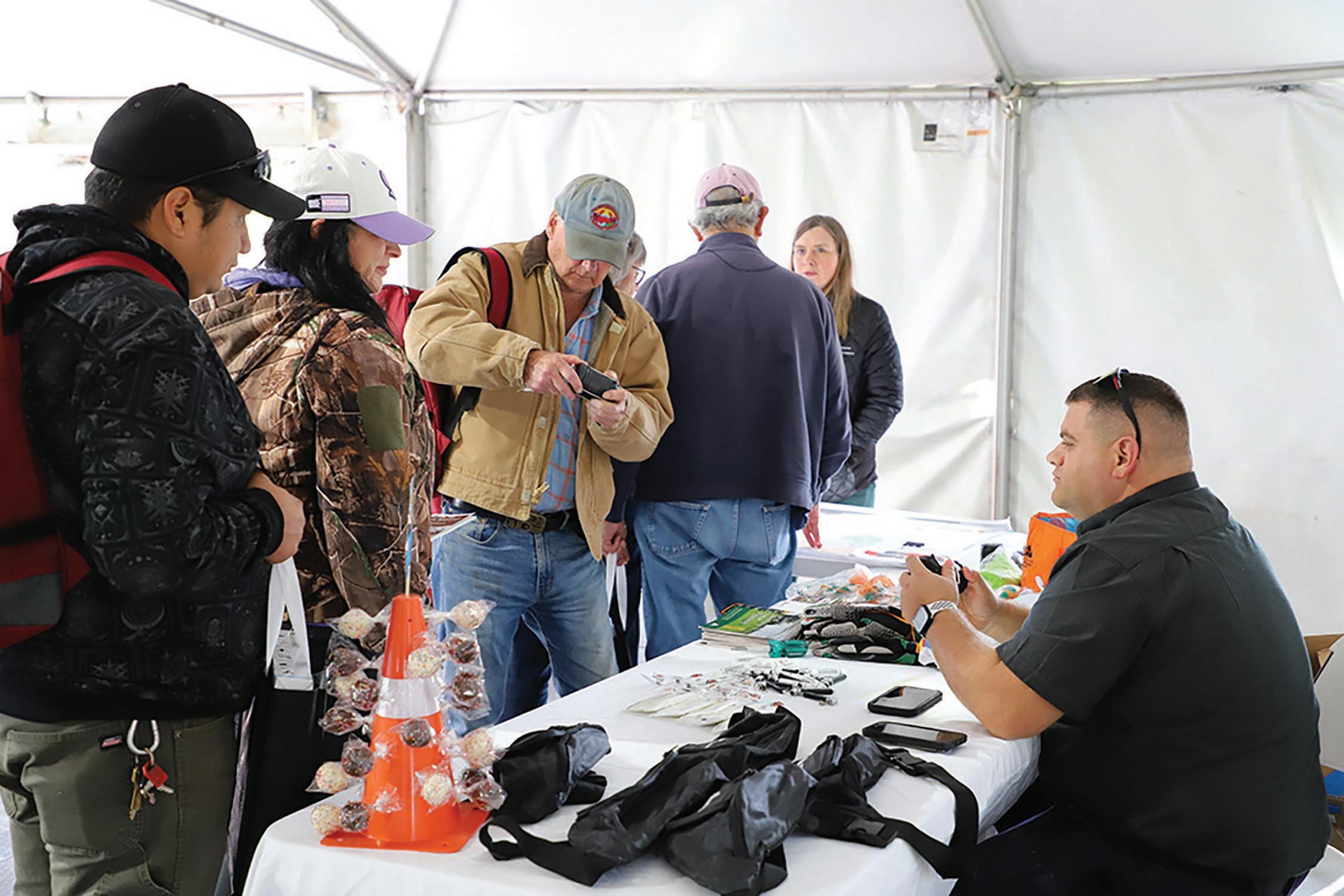
Lots of items up for grabs to help everyone be prepared when disaster strikes
SCOTTIE MILLER, ARCHIVE ASSISTANT
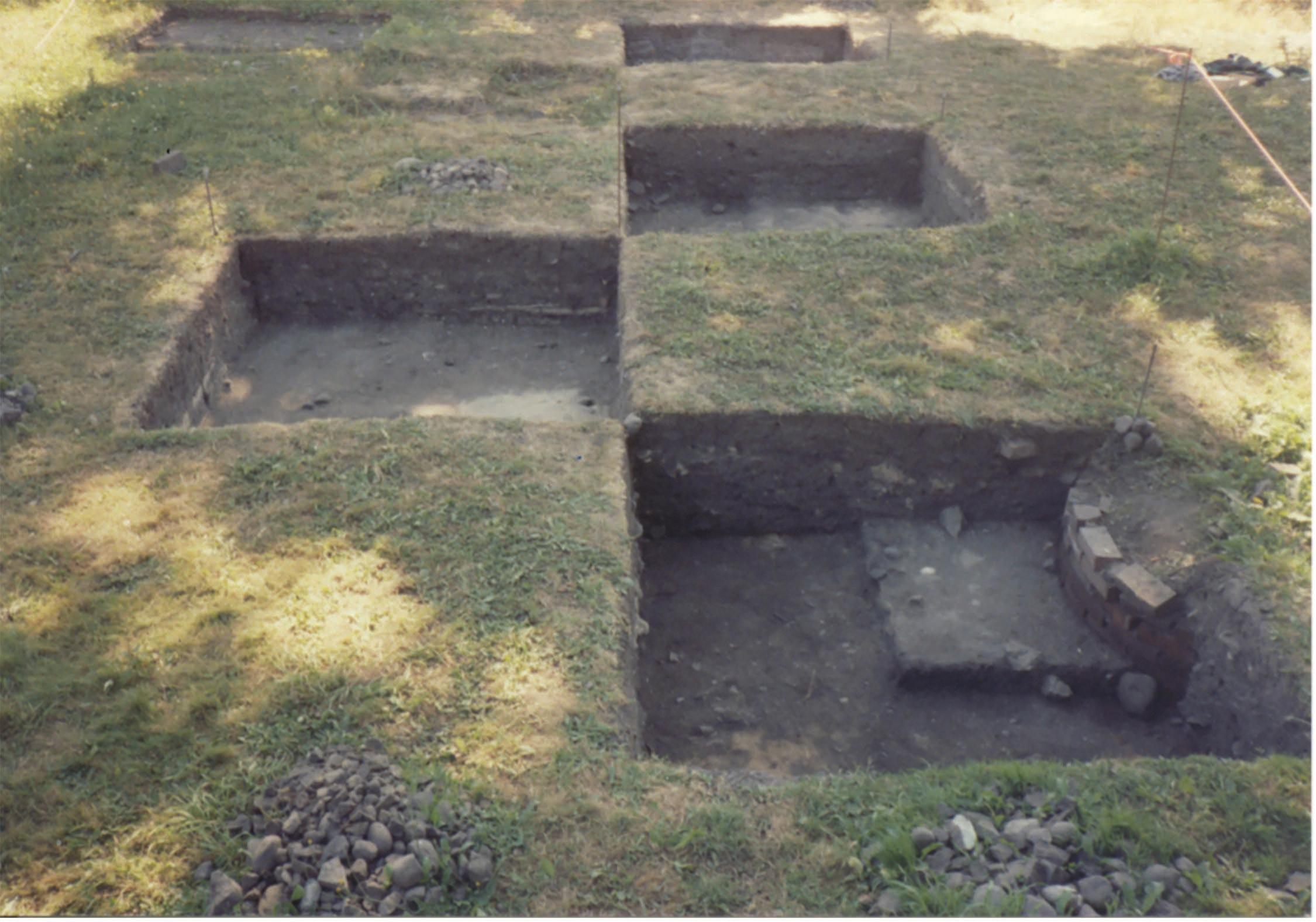
Happy fall from your Swinomish Tribal Archive!
I am Scottie Miller, I started at the Archive in July. I graduated from Western Washington University (WWU) in June of 2023 with a degree in anthropology. Part of my coursework at WWU included Native American anthropology, archaeological methods, and a class about Eurasian Paleolithic archaeology. (Which is just a fancy way of saying archaeology of past humans and their connection to stone tools). All three of those courses helped shape my perspective and knowledge, and I get to put them to use here at the archive.
Due to my passion for archaeology, I’ve been graciously tasked with rehousing and preserving artifacts from the Twiwoc archaeological digs over the years. It has been really special to me to process and catalog each of the artifacts. I’ve gotten to handle some early stone and bone tools along with many historics. I have been able to process over 700 artifacts, all of which were very meaningful work, knowing that my ancestors once handled them.
One of the artifacts that caught my attention while rehousing items from the Twiwoc dig was the start of a ‘Welcome Figure.’ These little figures depict a person standing (or sitting) with their hands raised, which, as many of you know, is still one of our customs today. In 2008, Dr. Astrida Blukis Onat published a paper on the multiple welcome figures found in our traditional range. They have been found at Twiwoc, along the Skagit River, and in the islands.
Onat is an archaeologist who has helped in the preservation of items left behind by our ancestors by conducting archeological digs for the Swinomish Tribe. She was a Seattle Central Community College professor and often had her students work on digs for her field school. Onat’s first dig involving the Swinomish Tribe and its historical range was in ‘Fish Town’ on the banks of the Skagit River in 1968. She worked on a plethora of digs on the Reservation and traditional areas over the years – most notably Fishtown, Munk’s Creek, Maylor’s Point, and Twiwoc.
Some of you may be familiar with the Twiwoc dig that occurred in the 90s before the Dental Clinic was built, near the old dental trailer. Twiwoc is one of our traditional villages, on the banks of the Swinomish Channel.
Twiwoc is unique compared to other digs because Swinomish youth were involved, and is an ongoing dig with the current Tribal Historic Preservation Office crew. Some artifacts found can be traced back to pre-contact times, such as stone or bone tools, while other artifacts called ‘historics’ can be very recent and left behind by us in modern times.

Welcome Figure. Found at Fishtown Dig C. 1973
Astrida Onat Collection
Swinomish Tribal Archive
I have a passion for sharing my knowledge of anthropology and archaeology and would love to assist anyone interested in learning more! For any inquiries, Krista and I can set up appointments for research through our emails. Feel free to contact us. I can’t wait to see you in the Archive!
Scottie Miller, Archive Assistant smiller@swinomish.nsn.us
Krista Hamburg, Archive and Records Manager khamburg@swinomish.nsn.us




Improving mental and behavioral health through animal-guided programs and mentorship with Swinomish youth in Bellingham.
Animals as Natural Therapy has been working with our Swinomish youth for many years. This summer youth attended a week long program with support from animalguided mental and behavioral health programming.
Animals as assisted therapy is based on the knowledge that animals can teach important life skills such as respect for self and others, healthy boundaries, selfmanagement, empathy, and clear communication.
Their Equine Assisted Learning programs utilize techniques from Professional Association of Therapeutic Horsemanship, and Equine Assisted Growth and Learning models while the Equine Assisted Therapy program integrates clinical mental health treatment with horsemanship to uniquely address a variety of participant needs, including anxiety, depression, grief, trauma, and PTSD.

Animal-assisted therapy (AAT) can have many benefits, including:
Helping with depression, anxiety, and other mental health issues. The presence of an animal can trigger the release of hormones like serotonin, oxytocin, and prolactin, which can reduce stress and anxiety, and improve mood.
Social interactions – AAT can help people improve their social interactions and communication skills.
Providing comfort and distraction, especially in stressful situations like cancer treatment or after a loss.
Breaking the ice between a therapist and patient, which can reduce resistance to therapy.
Memory: AAT can help with memory recall and sequencing temporal events for patients with head injuries or chronic
AAT can be effective for children, adolescents, adults, and elderly patients.
“Animals as Natural Therapy camp has been one of my favorite experiences to share with students over the past few years. It consistently provides a positive and supportive environment for everyone involved. The animals themselves offer immense comfort and emotional support as well.
"The daily group activities enhance our students’ communication and teamwork skills and foster personal growth. It was incredible to witness the transformation in our students during just one week at the camp. Initially, some students were reserved and quiet, but by the end of the week, they became more open and willing to participate in activities. Additionally, they learned valuable skills in caring for other beings, which positively influenced their relationships with peers and adults.

June 10, 1987 – Max is awakened by his alarm at 6 a.m.
“Man, I am tired and today is the last day of school.”
Max rubs his eyes and yawns as he climbs out of his bed from a deep slumber. The day is full of excitement.
DEAN DAN JR., SWINOMISH TRIBAL MEMBER
“Next year, we won’t have to take the bus, bro. We can get in your boat and float to school,” Stan said with a crooked smile.
The Solah boys belong to a long legacy of generational fishermen and fisherwomen. Each generation collects and passes along vital information about creatures only existing in the world of the water beings. These influential







COLLEEN MAVAR, FITNESS CENTER

Sticking to an exercise routine is challenging for just about everyone, which is why it is vital to have exercise motivation tips and strategies that are proven effective in developing long-term exercise habits. Did you know that regular exercise reduces the risk of Type 2 diabetes, cardiovascular disease, certain cancers, depression, anxiety and obesity? Yet, 80% of adults do not meet the recommended guidelines for aerobic exercise or resistance exercise.
According to research, the most common reasons given for not participating in exercise are lack of time due to family or work, motivation, safe environment to exercise, and social support, and caregiving responsibilities. Interestingly, most individuals who drop out of an exercise program do so within the first six months of starting the program.
To counter this exercise drop-out phenomenon, research on this topic indicates that health and exercise professionals sought to target the selfefficacy behaviors of the person starting an exercise program to help them adopt a longterm exercise program. This means finding ways to support people in their initial desire for optimal health and fitness and provide them with an exercise program that includes tools to help them succeed.
These tips help target a person’s self-efficacy to adopt an exercise program and avoid dropping out. As you read through this list, identify those strategies that resonate with you and fit best with your lifestyle, then incorporate those that will make the biggest impact.
Here’s a quote to remember... Your body will achieve what your mind will believe. If you believe you can achieve your health and fitness-related goals, you’re more than halfway there. You got this!
1) Establish achievable and realistic fitness goals that align with your abilities, health, and lifestyle. Consider posting them somewhere in your house as positive reminders. Break down your short-term (three month) goals into achievable 2-3 week targets to keep yourself motivated and on track.
2) Create a weekly schedule and include your exercise time. Plan your workouts in advance and incorporate them into your weekly schedule to make them a consistent part of your routine.
3) Start slow. Gradually advance into your exercise routine to avoid injury, allowing your body to adapt to the new physical demands.
4) Discover workouts you enjoy. Choose several different workouts (gym, home, and outdoors) you enjoy to increase the likelihood of sticking with it.
5) Mix it up. Prevent boredom by diversifying your workouts with different sections, including cardio, strength, flexibility, and mind/body exercises.
6) Get the right gear. Invest in comfortable workout attire and appropriate footwear to enhance your overall exercise experience.
7) Track your progress. Keep a record of your fitness achievements and improvements to stay motivated and to track your journey to optimal health.
8) Have fitness friends. Consider engaging in smallgroup activities by creating or joining a social network of exercise enthusiasts (like a walking club).
9) Reward yourself. Establish a non-food reward system (watch a movie, read a book, or spend time on a hobby) for reaching fitness and health goals.
10) Incorporate music or podcasts. Create a workout playlist or listen to podcasts while you exercise to make your sessions more engaging.
11) Prioritize consistency. Focus on maintaining a regular exercise routine rather than pushing yourself too hard in sporadic high-intensity workouts.
12) Seek support of significant others. Let friends and family know your exercise goals so they can encourage and support you in achieving them.
13) Find a workout buddy. Partnering with someone can provide accountability and make exercising more enjoyable. It helps if your workout buddy is at about the same fitness level as you.
14) Set reminders. Use mobile alerts or smartphone apps to remind yourself of scheduled workouts and movement “snacks” to keep you on track.
15) Explore the outdoors. Weather permitting, take advantage of outdoor activities such as hiking, biking, and walking to add variety.
16) Monitor your body signals. Pay attention to your body’s internal signals (energetic, tired, or sore) and adjust your workouts accordingly to prevent overexertion and injury.
17) Fine tune your diet. Match your physical training demands with a health-promoting dietary pattern for optimal performance and recovery. Note, you can’t out-exercise a bad diet!
18) Create a vision board. Compile images, drawings, and quotes that inspire you to stay dedicated to your fitness journey.
19) Mini workouts count. On days when you are feeling short on time, try combining a brisk walk, some squats, push-ups, and crunches into a 10-minute mini workout. These mini workouts count in your journey to mental and physical health.
20) Set a consistent bedtime routine. Ensure you get enough sleep (seven to nine hours) to support your energy levels, health, and exercise recovery.
21) Invest in professional exercise guidance. Consider hiring a personal trainer to provide expertise, education, and motivation tailored to your fitness goals.
22) Use technology. Utilize fitness apps, wearables, or online platforms to monitor your progress and gain insight into how to improve your workouts.
23) Establish pre- and post-workout routines. Develop a pre-exercise routine, such as a brisk walk, that signals your body it’s time to get active, mentally and physically preparing you for your workout. Design a post-exercise routine that includes some favorite stretches and mind/body breathing activities.
24) Make it a habit. Consistency is key. Stick with your exercise routine until it becomes a hvabit that you naturally incorporate into your daily life.
25) Stay positive. Maintain a positive mindset, focus on the health benefits of exercise, and don’t let setbacks keep you from your long-term journey of succeeding with your exercise goals.













Meet the staff: Taysha James Sherman
Boys & Girls Club Office Manager Taysha James has worked with Swinomish youth since 2014, and started at the Boys & Girls club in June of this year.
Her favorite color is purple and she loves eating mashed potatoes. Maui is where she prefers to be so she can swim with the turtles, her favorite animal. When Taysha listens to music she prefers the 2000s era. Fall is her favorite season, and her most cherished movies are “Matilda” and “Annie”. She loves watching the Seattle Storm play. In her free time she enjoys playing rec softball and volleyball, coaching, and doing henna.
Some fun facts about Taysha are that she has a twin brother (Jamall) and that she can skateboard, a little. When Taysha grows up, she wants to be Angela Ball.
Meet the staff: Isaiah Miller
Isaiah is a youth development professional at the Boys & Girls Club. He has worked with the club for about a year, and the youth like to call him Miller.
Isaiah’s favorite animal is a panda and he likes the color purple. He loves a good burger and fry combo, his favorite place is California. Isaiah enjoys listening to music but prefers the 50s and 60s jams. His favorite sport is football and all-time favorite movie is “Scott Pilgrim Against the World”. Isaiah prefers the winter season and in his free time likes to go golfing, drive around, and listen to music.
Some fun facts about him are that he is left-handed, he plays the drums, and he skipped kindergarten. When he grows up, he wants “to be a professional boxer”.
Caylen Bobb is our November youth of the month. Caylen is 5 years old and in kindergarten. Her favorite movie is “Frozen” and she loves the color pink.
In Caylen’s free time, she enjoys coming to the Boys & Girls Club to play. She loves Halloween and her favorite princess is Elsa. Something you may not know about Caylen is that her favorite sport is running.
Caylen was selected as our youth of the month because of her caring nature, willingness to be a friend, and always offering to help.

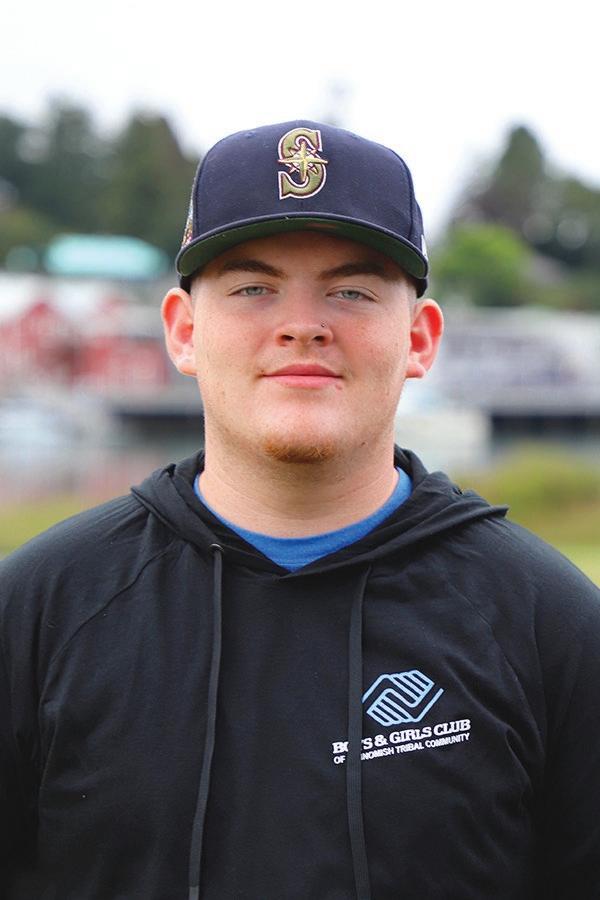













November Activities
♦ Sewing Club - Wednesdays with Lynn Beebe, 3 p.m.
♦ Snack Making - Tuesdays with Michelle Skidmore
♦ Photography Club - November 7 and 21, 3:30-4:30 p.m., with Katie Bassford
♦ Teen Night - November 1, 8, 15, 16, 22, 23


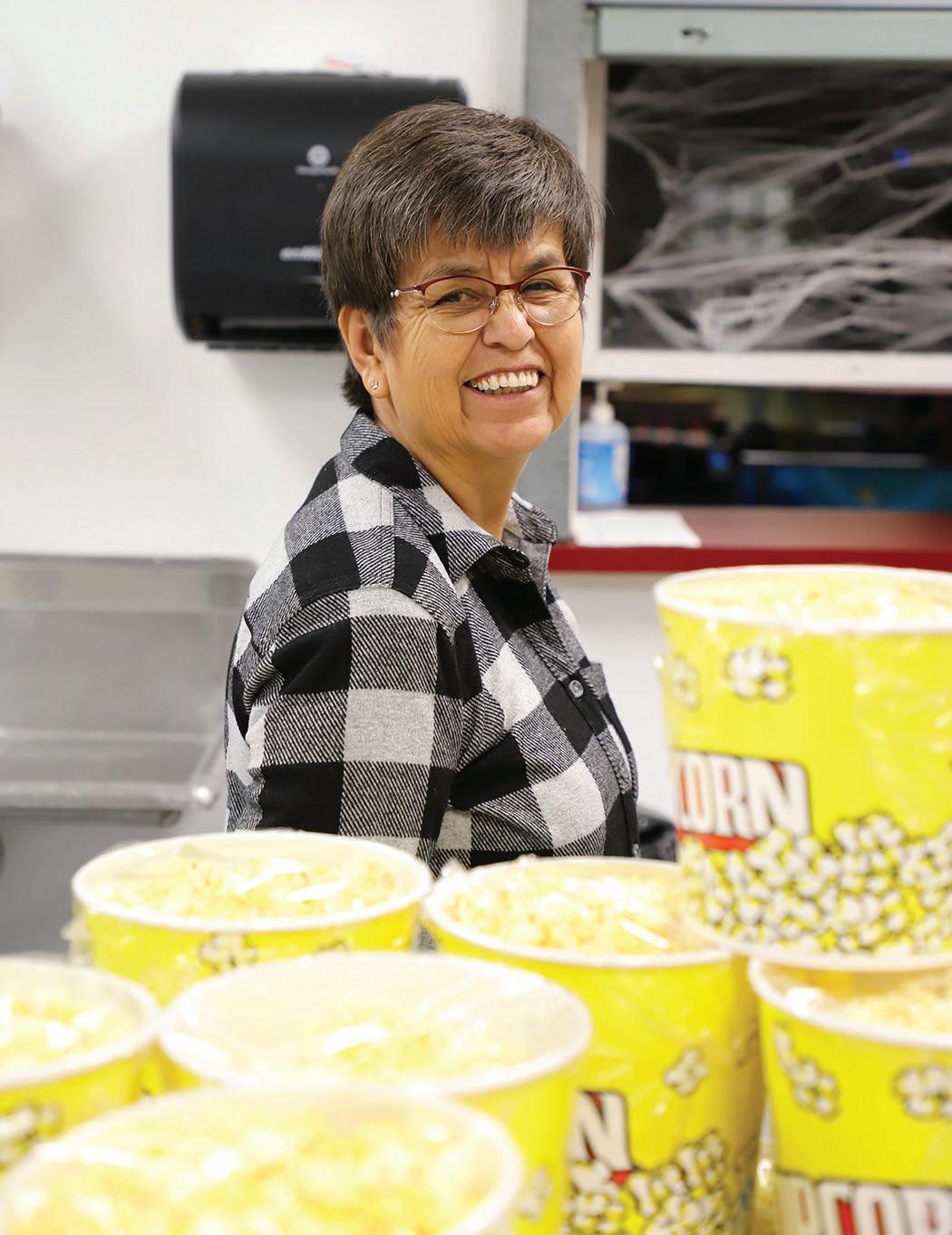










































































A king tide is a non-scienti c term used to describe exceptionally high tides. They occur when the alignment of the Earth, moon, and sun creates the strongest gravitational pull, often happening during a new or full moon when the moon is closest to Earth (perigee).
King tides can cause flooding in low-lying coastal areas, particularly when combined with storm surges. Whether on roadways or anywhere else, do not drive into or enter flood waters. King tides can also contribute to storm surge, as well as erosion, saltwater intrusion into agricultural areas, home and infrastructure damage, and general disrup tion to daily living.
King tides are a preview of what higher sea levels will look like in the future. As the planet adapts to climate change, the tides we see during king tides today could become the new normal.
Nov 16 (5:49AM)
Nov 17 (6:42AM)
Nov18 (7:36AM) Nov 19 (8:30AM)

Dec 16 (6:38AM)
Dec 17 (7:24AM)
Dec 18 (8:09AM)
Jan 1 (7:08AM) Jan 2 (7:44AM)
Jan 3 (8:19AM)
Jan 4 (8:53AM)
Jan 13 (5:42AM)
Jan 14 (6:21AM) Jan 15 (6:58AM) Jan 16 (7:32AM) Jan 30 (6:31AM) Jan 31 (7:02AM) Feb 1 (7:32AM)
GINGER JOHNSON, SUDP, WSGCC1
Program staff welcome the opportunity to explore treatment options with tribal members and their families. Newly extended program hours are Monday-Friday, 8 a.m.-5 p.m. Some of the services available to support the journey to recovery include:
♦ Substance use disorder assessment for DUIs and deferred prosecution.
♦ Individual therapy sessions, outpatient group sessions, inpatient treatment referrals along with arranging detox services.
♦ Assistance with mental health referrals to Swinomish Behavioral Health and didgʷàlič, along with medical services including dental. You are not alone in your journey
♦ Groups activities including cultural arts and crafts, healing arts, beading, singing/drumming group, Red Road to Recovery, painting, and Talking Circles. Groups help promote self-care, gaining interest in old and new hobbies that are sober, and enhances overall well-being (spiritual, physical, mental and emotional). We offer this and more, please come see us.
♦ Gaming awareness and gambling relief counseling.
The Family Education and Support Group meets every second and fourth Thursday of the month, 5:30-6:30 p.m., in the Swinomish Wellness Center group room located in the Social Services Building. Support, education, and resources for individuals with loved ones affected by substance use disorder.
Call us for more information!
Swinomish Wellness Program (360) 466-1024
Ginger Johnson Manager (360) 588-2868
For the last open positions, please visit: swinomish-nsn.gov/resources/humanresources

For the latest open positions, please visit: swinomishcasinoandlodge.com/careers/
For the latest open positions, please visit: didgwalic.com
Please submit articles, photos, announcements and celebrations to: qyuuqs@swinomish.nsn.us
11406 Moorage Way La Conner, WA 98257
qyuuqs@swinomish.nsn.us
@qyuuqsNews
